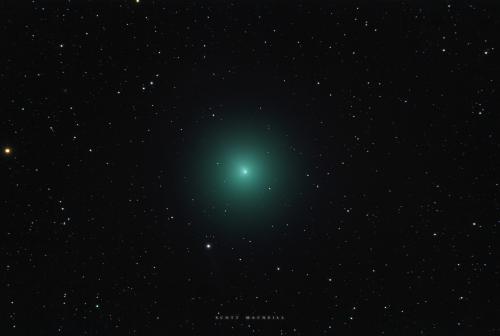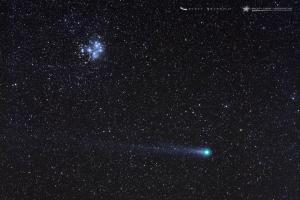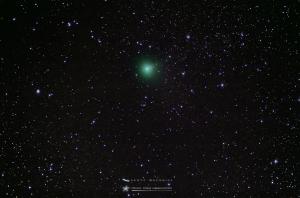Celebration of Space - January 13, 2023

Comet 46P/Wirtanen over Frosty Drew Observatory. Credit: Frosty Drew Astronomy Team member, Scott MacNeill.
At 6:10 pm EST on January 6, 2023, the January full Moon happened. Notably, the January full Moon usually occurs during the time that the Moon is at its furthest point from Earth, called Apogee. In 2023, the January lunar apogee occurred at 4:20 am EST on January 8, 2023. There are some that considered it a “Micromoon” (opposite of a Supermoon), though at 34 hours apart, we at Frosty Drew do not agree with that determination. The January Moon carries several monikers, though in North America we call it the Full Wolf Moon. Even though we do not have wolves in Rhode Island, anybody who has visited Frosty Drew Observatory during this time of the year has likely heard the coyotes howling the night away. This is why the January Moon gets its name. During January, wolves will be the most chatty. They do this as a social construct, territorial notification, and to coordinate their hunt. Other names that the January Moon carries include the Cold Moon, Frosty Exploding Moon (this one is awesome), Freeze Up Moon, Hard Moon, and Goose Moon. Regardless of what you call the January Moon, Southern New England continues to miss out on a view of the night sky due to clouds. Now that the Moon is waning towards the New Moon, which occurs on January 21, 2023, the dark sky is returning. All we need now is a break in the persistent clouds of 2023 over Southern New England.
Comet C/2022 E3 ZTF continues to meet expectations and brightening continues as the comet moves towards its closest approach to Earth on February 1, 2023. Is this comet a first-time visitor, or has it been here before? There are a lot of unknowns when we have a new long period comet come into the inner Solar System. Long period comets have a greater than 200 year orbital period, and often originate from the Oort Cloud, the furthest edge of the Solar System. The comet reached perihelion, the closest approach it will make to the Sun, on Thursday, January 12, 2022, which currently places us at the start of the best viewing period. Over the days following perihelion, Comet E3 will continue its approach to Earth, passing by on February 1st at a distance of 26,406,202 miles. Regarding visibility, the comet will likely remain invisible to the naked eye, though will become quite visible when viewed through binoculars or a modest backyard telescope. At 8:00 this morning (January 13, 2023) the comet entered the constellation Bootes, and left Corona Borealis, where it has been for the past month. Over the next few weeks, the comet will pass through Bootes, Ursa Minor, and eventually Camelopardalis, which is where it will be when it makes its closest approach to Earth on February 1st. Once the bright Moon departs the night sky, we will be showing off Comet E3 in our telescopes at Frosty Drew. So make plans to visit over the next month and catch a view of the first comet of 2023.
Regarding the green color of Comet C/2022 E3 ZTF, there have been some exceptionally overstated news publications of late. The green color is only visible in the gas cloud that surrounds the comet’s nucleus, called the coma. It is not unusual for a comet’s coma to appear green / cyan in color, and many long period comets that pass through have this same phenomena. See our galleries of past comets:
Comet 46P/Wirtanen
Comet C/2014 Q2 Lovejoy
Comet C/2013 R1 Lovejoy
Other comets we have imaged at Frosty Drew
The green color in Comet E3’s coma, as well as in other comets, is a product of the presence of Diatomic Carbon (C2). This molecule is a product of vaporized carbon, which will occur in the comet’s nucleus as it encounters the intense solar wind of the inner Solar System. Unfortunately, the green color will not be visible when observing the comet visually (naked eye, binocular, telescopic) and will only appear as a faint grey. A camera can capture photons over several minutes, which will allow for the color to become visible. Please do not expect to look up in the sky and see a bright green comet zipping by. It is still unlikely that the comet will become visible to the naked eye, and if it does, it will likely be much dimmer than Comet F3 NEOWISE was in summer 2000. Regardless, we will offer views of Comet E3 as it moves into the nighttime sky over the next month. If the comet gets brighter than expected, we may also host special events themed on viewing the comet. Be sure to check our events calendar for updates: https://frostydrew.org/events. In the meantime, here is a chart to keep up with the progress of Comet E3 through its closest approach to Earth. Happy comet hunting!
- Author:
- Scott MacNeill
- Entry Date:
- Jan 13, 2023
- Published Under:
- Scott MacNeill's Columns



